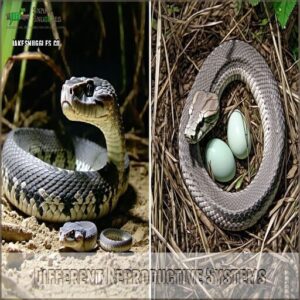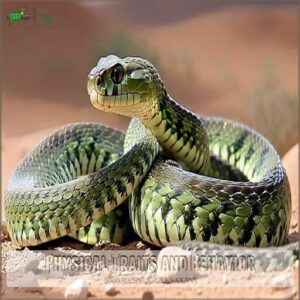This site is supported by our readers. We may earn a commission, at no cost to you, if you purchase through links.
 Yes, rattlesnakes can breed with other snakes, but only those closely related within the same genus (Crotalus or Sistrurus).
Yes, rattlesnakes can breed with other snakes, but only those closely related within the same genus (Crotalus or Sistrurus).
You won’t find a rattlesnake-python hybrid slithering around! These venomous reptiles follow strict genetic compatibility rules, just like you can’t cross a cat with a dog.
Within rattlesnake species, hybrids do occur both in the wild and captivity, often displaying mixed physical traits from both parents.
Notably, closely related pit vipers like copperheads can sometimes produce viable offspring with certain rattlesnake species. The resulting hybrids might display modified rattle structures or venom compositions that reveal their mixed ancestry.
Table Of Contents
- Key Takeaways
- Rattlesnake Reproduction Basics
- Rattlesnakes and Other Snake Species
- Why Rattlesnakes Can’t Breed With Bull Snakes
- Rattlesnake Mating and Hybridization
- Hybrid Rattlesnakes: Characteristics and Implications
- Rare Instances of Rattlesnake Hybrids
- Conservation and Ecological Roles
- Frequently Asked Questions (FAQs)
- Do copperheads and rattlesnakes cross breed?
- Can a gopher snake breed with a rattlesnake?
- Can a black snake and copperhead mate?
- Can a Python mate with a rattlesnake?
- Can rattlesnakes breed between the lines?
- Can rattlesnakes breed with other snakes?
- Can king cobras mate with rattlesnakes?
- Can rattlesnakes breed with gopher snakes?
- Can a Python and a rattlesnake interbreed?
- Do Copperheads mate with rattlesnakes?
- Conclusion
Key Takeaways
- Rattlesnakes can only breed with closely related species within their own genus (Crotalus or Sistrurus), making hybridization with distant species like pythons or cobras biologically impossible due to genetic incompatibility.
- You’ll find that rattlesnake reproduction is specialized – they’re ovoviviparous (giving live birth after internal egg development), can store sperm for years, and use specific pheromones as mating signals that prevent cross-species breeding.
- When hybridization does occur between closely related rattlesnake species, the offspring often face health issues including weaker venom, reduced fertility, and shorter lifespans – many hybrids are completely sterile.
- Conserving rattlesnake populations is crucial as they’re keystone predators that maintain ecological balance by controlling rodent populations, yet they face significant threats from habitat loss, climate change, and human persecution.
Rattlesnake Reproduction Basics
Rattlesnakes have a fascinating reproductive process, with males competing for mates during the warmer months of spring.
Females can even store sperm for years, ensuring they produce offspring when conditions are just right.
Mating Season and Rituals
When spring warms the air, rattlesnake breeding shifts into high gear, fueled by fascinating mating rituals and precise pheromone detection. Males use these chemical signals as a natural GPS to track females across rocky deserts and grassy habitats.
You might witness the dramatic "male combat," where two males wrestle in a gripping display of strength—not venom. **Their ritual focuses on dominance, intertwined bodies writhing in an unspoken dance for breeding rights.
Females signal readiness with subtle movements and chemical cues, guaranteeing only the fittest males proceed. This process safeguards successful reproduction.
- Picture it: two rattlesnakes twisted together like living rope, sliding across warm stone under moonlight.
Such mating rituals, evolved over millions of years, facilitate effective snake breeding while conserving energy and reducing conflict among these remarkable reptiles.
Reproductive Strategies
Rattlesnakes have unique reproductive strategies that make them fascinating creatures. One remarkable trait is their ability to store sperm for up to five years, which lets them delay fertilization until conditions improve. It’s a survival tactic that guarantees breeding success even in tough environments.
Unlike egg-laying reptiles, rattlesnakes are ovoviviparous, meaning embryos develop inside the mother before live birth. This offers protection during development and results in fully formed offspring with venom glands and hunting instincts from the start.
Unlike most reptiles, mother rattlesnakes carry their young internally until they emerge—fully armed with venom and ready to hunt.
- Typical litters range from 1-25 babies, each ready to fend for themselves immediately after birth.
Female rattlesnakes reproduce every 2-3 years to conserve energy, a necessary adaptation for survival. Despite their breeding success, snake hybridization is extremely rare in rattlesnakes. Their reproductive isolation hinges on pheromone-based behaviors, which prevent interspecies breeding. These systems safeguard genetic integrity, maintaining resilience within rattlesnake populations, and support their breeding success with a unique method of reproduction that is highly effective.
Venom and Its Role
Venom might seem like just a weapon, but it does much more—it even affects reproduction. The strength and composition of venom influence how well rattlesnakes survive and reproduce. Stronger venom guarantees better hunting, digestion, and energy conservation, which ultimately leads to healthier offspring.
Here’s a quick look:
| Venom Component | Role in Reproduction |
|---|---|
| Hemotoxins | Aids digestion for embryo health |
| Neurotoxins | Improves prey capture efficiency |
| Digestive enzymes | Maximizes nutrient extraction |
| Unique proteins | Signals genetic fitness to mates |
Venom differences also play a key role in species barriers during rattlesnake crossbreeding or snake hybridization. Mismatched venom composition prevents viable venomous snake hybrids, reinforcing species distinctions through venom evolution. Certain species, like the timber rattlesnake, have a type II venom, characterized by high lethality.
Rattlesnakes and Other Snake Species
You might wonder if rattlesnakes can breed with other snakes, but it’s a lot more complicated than it sounds.
Genetic differences and unique reproductive barriers make it nearly impossible for rattlesnakes to interbreed with species outside their genus.
Can Rattlesnakes Interbreed?
A rattlesnake sticking to its species isn’t random—it’s science.
Snake hybridization requires precise alignment, but rattlesnake crossbreeding proves tough due to strong genetic barriers.
Here’s why hybrids are rare:
- Genetic Incompatibility: Chromosomes won’t align correctly.
- Unique Venom Systems: Designed for survival, not sharing.
- Mating Signals: Different cues confuse potential pairs.
- Evolutionary Limits: Species prefer genetic stability.
- Nature’s Guards: Isolation preserves species barriers.
Hybrid viability? Practically impossible—rattlers keep it exclusive!
Factors Influencing Interbreeding
In the context of rattlesnakes and interspecies breeding, nature has strict guidelines.
Successful snake hybridization depends heavily on factors like genetic compatibility, habitat overlap, and synchronized mating behaviors.
Chromosome mismatches often make hybrid viability a long shot, turning most crossbreeding attempts into evolutionary dead ends.
Behavior plays a big role, too.
Snakes rely on pheromones (essentially their dating profiles), and misaligned signals mean no interest.
Reproductive isolation—like mismatched mating seasons—can also put a hard stop to rattlesnake crossbreeding.
Plus, if species don’t share territory, there’s no chance for romantic “meet-cutes” either.
These barriers keep rattlesnake genetics fine-tuned for survival.
While snake hybridization sounds fascinating, it’s rare, with nature favoring species that stick to their own.
Bottom line: rattlesnakes are picky for good reason—it’s all part of their survival strategy.
Why Rattlesnakes Can’t Breed With Bull Snakes
Rattlesnakes and bull snakes can’t breed because their genetic makeup and chromosome numbers are too different to create viable offspring.
Their reproductive systems and mating behaviors are also incompatible, making crossbreeding biologically impossible.
Genetic Makeup and Chromosome Numbers
You might think rattlesnakes and bull snakes could cross paths genetically, but snake genetics say otherwise.
Their chromosomes don’t match—rattlesnakes have 36, bull snakes 34—blocking interspecies breeding.
Here’s a key fact:
- Chromosome Compatibility Matters: Without matching chromosomes, reproduction isn’t possible.
Genetic divergence, highlighted by genome sequencing and mutation rates, creates an unbreachable wall between them.
Understanding snake morph inheritance clarifies why these crosses are impossible.
Hybrid viability? Zero chance.
Evolution’s firewall keeps these species separate, ensuring their unique traits stay intact.
Nature’s rules, right?
Different Reproductive Systems
Genetic barriers guarantee rattlesnakes and bull snakes can’t breed. Their reproductive biology is radically different, making hybridization a non-starter. Rattlesnakes use ovoviviparity, giving birth to live young after internal egg development, while bull snakes rely on oviparity, laying eggs externally.
Even if they attempted to mate, mismatched anatomy, genetic incompatibility, and reproductive isolation would prevent success. Differences in activity patterns, sperm storage, and parthenogenesis also play a role in keeping them apart.
Here’s a quick comparison:
| Characteristic | Rattlesnakes | Bull Snakes |
|---|---|---|
| Birth Method | Ovoviviparity | Oviparity |
| Sperm Storage | Yes | No |
| Parthenogenesis | Rare | More common |
| Activity Patterns | Mostly nocturnal | Primarily diurnal |
Ultimately, these reproductive barriers maintain clear distinctions between species.
Rattlesnake Mating and Hybridization
Rattlesnakes can mate with closely related species, but strict genetic and behavioral requirements make hybridization uncommon. Understanding how these snakes reproduce highlights the fascinating balance between biology and environmental factors.
Intraspecific Breeding
When it’s about intraspecific breeding, rattlesnakes know their stuff.
They stick to their own species, keeping population health strong. Using pheromone trails as nature’s GPS, males seek compatible mates, often battling rivals in fascinating “combat dances.”
Females, ever strategic, store sperm for years to time fertilization perfectly, ensuring robust offspring. Variations in behavior exist across geographic subspecies, but all rattlesnake species focus on maintaining genetic diversity to avoid inbreeding risks.
- Fascinating Fact: Larger males often win breeding rights, playing a critical role in sustaining rattlesnake biology, particularly through captive breeding programs aimed at preserving population health.
Interspecific Hybridization
When discussing snake hybridization, interspecific hybridization—the mating between species within the same genus—is rare, even among rattlesnakes.
Nature has guardrails, called genetic barriers, that make cross-species breeding tough. For rattlesnakes, those barriers include differences in pheromone signals, habitats, and mating cycles.
Think of pheromones as a species-specific "dating app"—if the signals don’t align, the match simply won’t happen.
Even in captive breeding programs, where conditions are carefully controlled, producing venomous snake hybrids is no easy feat. Hybrid snake species that do form might show unique, sometimes unstable traits.
Hybrid viability often takes a hit, which can mean weaker venom, shorter lifespans, or other complications. This underscores how evolution naturally enforces strict rules, ensuring interspecific hybridization rarely reshapes the rattlesnake family tree in the wild.
Intergeneric Hybridization
Think snakes are matchmakers across species? Not quite—intergeneric hybridization with rattlesnakes rarely happens, and for good reason. Their genetic divergence creates insurmountable barriers, ensuring nature keeps boundaries intact.
Rattlesnakes’ chromosomes just don’t align with snakes from other genera, making hybrid viability almost impossible. Even in controlled captive breeding, hybrid snakes face sterility or health complications.
Why does nature play hardball here? Hybrid identification reveals clues in their DNA—like a lock that rejects the wrong key. Evolutionary implications remind us that rattlesnakes are specialists, not generalists.
So next time you hear rumors of rattlesnakes interbreeding with bullsnakes, remember the facts. If genetics were a dating app, rattlesnakes would swipe left on non-rattlesnakes every time due to:
- Vast genetic divergence.
- Distinct venom systems.
- Incompatible reproductive anatomies.
Snake hybridization? Fascinating—but strictly limited by biology.
Hybrid Rattlesnakes: Characteristics and Implications
Hybrid rattlesnakes inherit a mix of physical and behavioral traits from their parent species, often resulting in unique patterns or characteristics.
While intriguing, these hybrids can face health challenges and are typically sterile, limiting their role in the ecosystem.
Physical Traits and Behavior
Hybrid rattlesnakes are fascinating products of snake interbreeding, blending traits from their parent species in unexpected ways.
Their physical and behavioral characteristics highlight nature’s creativity, showcasing unique features developed through snake hybridization.
Here are five remarkable traits of hybrid rattlesnakes:
- Venom Composition: Hybrids have unpredictable venom blends, creating unique toxin profiles.
- Scale Patterns: Their scales display intricate, mixed designs, reflecting genetic diversity.
- Hunting Strategies: Hybrid vigor snakes adapt with combined predatory techniques, ideal for varied conditions.
- Sensory Perception: Heightened abilities help hybrids respond swiftly to threats.
- Defensive Mechanisms: Distinct rattle sounds and behaviors add unique survival tactics.
These rattlesnake offspring highlight the intricate balance of form and function in snake hybrids.
Health Issues and Sterility
Why do hybrid rattlesnakes struggle with health and fertility? Hybrid vigor in snakes doesn’t always translate to benefits. In fact, hybrid health often takes a hit due to genetic defects from mismatched chromosomes.
Sterility causes most hybrid offspring to be unable to reproduce, leading to sterile hybrids. One factor impacting their well-being can be respiratory infections and pneumonia. These rattlesnake offspring face developmental issues, reduced fertility, and weaker venom, which diminishes hunting success.
Physically, hybrids often have thinner bodies, making them more vulnerable to predators and natural challenges.
Here’s a comparative look at hybrid vigor snakes versus pure rattlesnakes:
| Trait | Pure Rattlesnakes | Hybrid Offspring |
|---|---|---|
| Venom Potency | High | Reduced |
| Fertility | Reproductive | Often Sterile |
| Lifespan | Long | Shortened |
| Physical Condition | Robust | Weaker |
Nature enforces strict reproductive limits for a reason.
Rare Instances of Rattlesnake Hybrids
You might be surprised to learn that rattlesnakes can occasionally produce hybrids, though it’s rare and mostly observed in controlled settings like captivity.
These unique cases happen only when closely related species meet the right conditions for mating.
Occurrences in The Wild
Out in the wild, rattlesnakes occasionally surprise us by bending the rules of biology. Snake hybrids in the wild are rare, but certain environmental factors—like shared habitats and geographic overlap—sometimes allow closely related species to interbreed.
Their ability to adapt, even slightly, reveals fascinating evolutionary implications. In the rugged terrains of the Peloncillo and Animas mountains, hybridization frequency increases where rattlesnake ranges intersect.
Here, natural barriers weaken just enough for interbreeding to occur. However, these hybrids lead fragile lives and rarely thrive. Their venom composition, including Mojavetoxin presence, can also vary greatly.
- **Shared habitats reduce natural isolation.
- **Overlapping ranges encourage snake hybrid offspring.
- **Harsh environments often limit survival rates.
- **Hybridization remains rare and localized overall.
Snake hybrid documentation from these cases illustrates nature’s tendency to experiment, but these hybrids remain the exception, not the rule.
Examples of Documented Hybrids in Captivity
Captive hybrid origins give scientists a unique window into the domain of snake hybrids, especially among rattlesnakes.
Breeding experiments have resulted in fascinating hybrids like Mojave x Prairie rattlesnakes, which display venom variability that keeps researchers on their toes.
Timber x Eastern diamondback hybrids, on the other hand, often have muted scale patterns and genetic quirks, making them striking examples of hybrid physical traits.
While some snake hybrids in captivity thrive, hybrid fertility rates can vary, with many being sterile.
You can even find products for these snakes available online.
Hybrid behavioral changes, like altered defensive tactics, are also closely studied, and these rattlesnake hybrids help us explore snake crossbreeding, hybrid longevity, and venom evolution, but they also highlight the fragile balance required for hybrid viability within controlled environments.
Conservation and Ecological Roles
You’ll find that rattlesnakes play a key role in maintaining healthy ecosystems by controlling prey populations and supporting biodiversity.
Conserving their habitats is essential to protect these important predators from threats like habitat loss and climate change.
Importance of Rattlesnakes in Ecosystems
Rattlesnakes are nature’s pest control experts, playing indispensable roles in maintaining ecological balance. As keystone predators, they regulate rodent populations, preventing overgrazing, crop damage, and disease spread.
Their hunting relies on heat-sensing loreal pits, a unique adaptation for precision. You might overlook how essential they are, but ecosystems depend on them.
Here’s why:
- Ecosystem Balance: Rattlesnakes prevent prey overpopulation.
- Rodent Control: They reduce agricultural losses and disease risks.
- Biodiversity Preservation: By managing prey populations, they protect plants and smaller wildlife.
Snake conservation guarantees thriving ecosystems!
Threats to Rattlesnake Populations
While rattlesnakes maintain ecosystem balance as keystone predators, they face mounting threats that endanger their survival.
Habitat loss remains their greatest challenge, with urban development fragmenting once-connected populations and reducing genetic diversity. Climate change disrupts their carefully timed brumation and breeding cycles, while road mortality claims thousands of snakes annually during migration periods.
- Snake hybrids receive much attention from enthusiasts, but wild rattlesnake populations need our focus – illegal collection for the pet trade and unnecessary killings due to fear further diminish their numbers.
The combined pressures of prey depletion and reduced genetic similarity between isolated populations create a perfect storm for these important predators. Supporting rattlesnake preservation efforts can help mitigate these dangers. Without rattlesnake conservation efforts, we risk losing species that have evolved over millions of years to fill specific ecological niches – a loss that would ripple through entire ecosystems.
Conservation Efforts
Conservationists champion rattlesnake protection through multi-faceted approaches that benefit entire ecosystems. Habitat Preservation initiatives secure critical spaces where these serpents maintain ecosystem balance, while Anti-Poaching enforcement disrupts illegal wildlife trafficking.
Public Education programs work to replace fear with understanding, helping communities recognize these animals’ ecological value rather than seeing them as threats.
You’ll find conservation groups creating wildlife corridors that allow for safe migration and genetic diversity exchange.
Many organizations also invest in Climate Resilience research to address how changing conditions affect rattlesnake populations and hybrid viability.
Supporting rattlesnake habitat conservation can aid preservation efforts.
Want to help? Support snake conservation by volunteering with local organizations, reporting wildlife crimes, or advocating for habitat protection policies—small actions that collectively guarantee rattlesnake conservation continues for generations to come.
Frequently Asked Questions (FAQs)
Do copperheads and rattlesnakes cross breed?
Copperheads and rattlesnakes don’t naturally crossbreed.
While both belong to the Viperidae family, genetic differences and mating behaviors create barriers.
Hybridizing them would require artificial conditions, and even then, it’s incredibly rare and scientifically challenging.
Can a gopher snake breed with a rattlesnake?
Gopher snakes and rattlesnakes rarely rendezvous romantically.
Despite sharing habitats, their genetic differences prevent successful breeding.
They’re more like neighbors than partners—similar lifestyles but biologically incompatible.
So, no venomous gopher snake hybrids lurking about!
Can a black snake and copperhead mate?
No, black snakes and copperheads can’t mate successfully.
They belong to different snake families with incompatible genetics.
Despite myths suggesting otherwise, these species have biological barriers preventing hybridization in both wild and captive settings.
Can a Python mate with a rattlesnake?
No, pythons can’t mate with rattlesnakes. They belong to different snake families (Pythonidae vs. Viperidae) with incompatible genetics, reproductive biology, and geographic origins that make successful breeding biologically impossible.
Can rattlesnakes breed between the lines?
Rattlesnakes can absolutely breed between different species within their own family.
You’ll find that closely related rattlesnake species can crossbreed, especially in overlapping territories, producing viable hybrid offspring with mixed characteristics from both parent species.
Can rattlesnakes breed with other snakes?
Yes, they can, but only with closely related species within their family.
You’ll find successful breeding limited to other rattlesnake species or very close relatives, as genetic and biological barriers prevent most cross-species mating.
Can king cobras mate with rattlesnakes?
King cobras and rattlesnakes can’t mate successfully due to their different family classifications (Elapidae vs. Viperidae).
They’ve evolved separately with incompatible genetic structures, reproductive systems, and mating behaviors that prevent hybridization.
Can rattlesnakes breed with gopher snakes?
Despite what some myths suggest, rattlesnakes can’t breed with gopher snakes. You’ll find these species are too genetically different, belonging to separate families (Viperidae vs. Colubridae) with incompatible reproductive systems.
Can a Python and a rattlesnake interbreed?
No, pythons and rattlesnakes can’t interbreed.
They belong to different snake families with incompatible genetics, reproductive systems, and evolutionary histories.
It’s like trying to cross a cat with a dog—biologically impossible.
Do Copperheads mate with rattlesnakes?
You’ll be interested to know that copperheads and rattlesnakes don’t mate with each other in nature.
They belong to different genera within the viper family, making natural hybridization between them biologically impossible.
Conclusion
Understanding rattlesnake breeding reveals fascinating biological boundaries.
While rattlesnakes can breed with other snakes, it’s limited to closely related species within their genus.
You’ll never encounter a rattlesnake-cobra hybrid in nature! These restrictions maintain ecological balance and species integrity.
When you’re hiking in rattlesnake territory, remember that each species plays a unique role in its environment.
The question "can rattlesnakes breed with other snakes" reminds us how genetic compatibility shapes the natural world we observe.
- https://ask2.extension.org/kb/faq.php?id=142780
- https://wenatcheeoutdoors.org/2023/08/11/snake-identification-and-snake-myths/
- http://www.venomousreptiles.org/forums/experts/17272
- https://www.mercurynews.com/2014/05/08/are-gopher-snakes-and-rattlesnakes-crossbreeding/
- https://herpunit.wordpress.com/2017/05/08/omg-hybrids/















